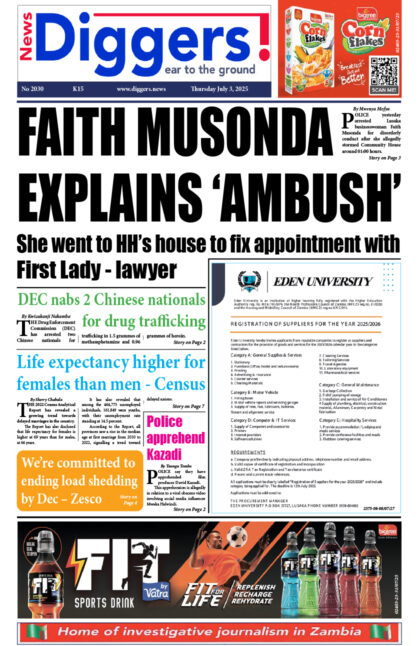The Lusaka High Court has thrown out Chilanga member of Parliament Keith Mukata’s application to cite the UPND Media Team for contempt saying he failed to identify the members of the team.
Meanwhile, a witness has told the court that Namakambwa Kwenda was shot at close range.
This is in a case in which Mukata and his lover Charmine Musonda are jointly charged with murder.
At the last sitting, Mukata’s lawyer Miller Katolo told the court that the UPND Media Team had caused to be published misleading information which labeled his client a murderer.
The defense lawyer said after Mukata gave his testimony on November 30, there had been screaming headlines on online media namely the Zambian Observer, Zambia Direct News, and Zambezi Post which read “I killed my company guard together with Kampyongo, says Mukata”.
Katolo prayed that a warrant be issued to the UPND media team so that they could explain why they shouldn’t be cited for contempt for misrepresenting proceedings and undermining the authority of the court.
But when the matter came up for continued defense yesterday, justice Susan Wanjelani ruled that any person who uses any speech or publication to misrepresent proceedings is liable to six months imprisonment or a fine of 50 units penalty fee.
She however said that Katolo had not identified who the UPND Media Team was or whether it was a person or an entity.
“There is insufficient information to invite the court to make a decision to order individuals unknown as counsel has not said whether the UPND Media Team is a person or an entity. In view of that I have dismissed the application,” said judge Wanjelani.
Meanwhile, Thomas Wolmarans, a South African ballistic expert who was a defense expert witness in the Oscar Pistorious trial, claimed that the bullet hole on the gate of Mukata’s law firm might have been caused by a reversing vehicle that had a pipe behind and not a gun because the hole had a shape like that of the spoon.
“When I look at the gate, the shape looks like a spoon and the mark on the hole might not have been caused by a bullet it has a triangular shape, maybe someone made a hole,” Wolmarans said.
The private ballistics expert who has been hired by Mukata to explain how he reconstructed the crime scene told Justice Wanjelani that Kwenda’s wound had a flame burn and the distance between the muzzle of the gun and his skin cannot be more than 1cm.
The South African national further testified that the dents on the gate and the wall did not have similar characteristics.
He said according to postmortem results, Kwenda might have been shot whilst seated contrary to what the ballistic officer who testified for the state indicated in his report that the shooter and the deceased were face to face.
“I don’t know where he got such information in relation to the wound,” said Wolmarans.
He said a ballistic officer should always examine the diameter of the wound in the presence of a pathologist in order to have similar measurements.
And Boniface Bwalya, an assistant registrar at the Health Professions Council of Zambia said only a certified medical practitioner was allowed to conduct postmortem.
Bwalya said according to Zambian laws, only medical practitioners were allowed to certify the cause of death and not other professions.
“It is difficult for me to comment about the ballistics because I do not know what they do or what their profession is all about because they are not medical practitioners,” said Bwalya.
The assistant registrar expressed ignorance about forensic pathologists attached to the police service, when asked by deputy chief state advocate Miriam bah Matandala if at all he was aware that some forensic pathologists were attached to the police service.
At this point, Katolo told the court that Bwalya’s testimony marked the close of Mukata’s defense and made an application to file in submissions on December 8.
In their response the state asked for two weeks in which to respond.
Justice Wanjelani granted the application and set February 28 2018 as date for judgment.




















One Response
very sad the poor man left children, justice must prevail. galatians 6v7 says you can not mock God.its time people learn that you need to love you neighbor as your self even if its your maid respect them because they come form God. if money is going to be used in this case i believe God is going to intervene for the berieved family